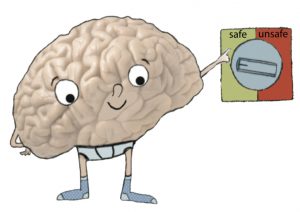The book: ‘My Bodyguard Brain – How your brain uses pain to protect you’ explains why we feel pain. Pain is never fun, but it is useful. Without our brain to guard our bodies, we wouldn’t feel any pain. If pain wasn’t unpleasant, you’d probably not even notice it and you might even carry on with playing. Now that it hurts, you’ll be careful with your leg for a while so that it has time to get better.
Any pain you feel anywhere in your body is made in your brain.

The brain is like a bodyguard: it makes pain when it notices any sort of danger. That danger can be in your body – appendicitis, for example – but it can also be on the outside. If your brain thinks it needs to protect you, it makes pain. The brain can also give you a tired feeling in your body or make you feel cold.
If you feel worried, sad or angry and you can’t do much about it, you may start to feel pain, even if there’s nothing wrong in your body. Your pain is really there. You’re not making it up; you’re not imagining it. Your brain thinks it has to warn you and it makes you feel pain in your body.
The text and drawings explain in a child-friendly way how your brain wants to look after you, how it works like a sort of bodyguard and how it sometimes gets a bit ‘too good’ at that job.
Science has taught us that thoughts, emotions and behaviour are important for the brain in terms of making pain, or not making pain. These things are just as important as the signals that come in from our bodies. The brain can make you feel pain even when there’s nothing wrong with your body.
Once children and their families understand that, it’s easier to work toward having the children (and their reassured parents) moving more as movement is really essential. Children (and parents) need to learn strategies to turn the oversensitive alarm down.
That is why the book ‘My Bodyguard Brain’ also has a chapter with information for caregivers, parents, family members and other people involved.
Understanding what you feel, is the first step to recovery.